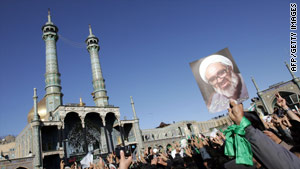Protests loom in Iran as holy day nears
- Iran may find it difficult to put a lid on the marking of Ashura this year
- It falls one week to the day after the death of Grand Ayatollah Hussein Ali Montazeri
- Montazeri, a key figure from the 1979 revolution, was an opponent of the current regime
- Ashura marks the martyrdom of Imam Hussein, grandson of Mohammed
(CNN) -- Iran could see widespread protests this weekend, as a day of mourning for the most prominent cleric to oppose the regime coincides with the major Shiite holy day of Ashura.
Iran -- whose regime exists as an explicitly Shiite Muslim leadership -- may find it politically and culturally difficult to put a lid on the marking of Ashura this year.
It falls on Sunday -- which happens to be a week to the day since the death of Grand Ayatollah Hussein Ali Montazeri, a key figure in the 1979 Iranian revolution. Montazeri, who went on to become one of the government's most vocal critics, died December 20.
The seventh day after a death is a traditional time for mourning in Islam, giving Iran's opposition two reasons to demonstrate on Sunday, both with impeccable religious justification.
But what exactly is Ashura and why does it draw such passionate crowds, some of whom beat themselves until they bleed?
The holy day commemorates the martyrdom of Imam Hussein, who died in 680 fighting to lead the religion based on the teachings of his grandfather, the Prophet Mohammed. The battle is one of the defining points in the split between the two main branches of Islam, the majority Sunnis and the minority Shiites.
Hussein was badly outnumbered when he was killed fighting Yazeed near the city of Karbala, in modern-day Iraq.
Shiites commemorate the death of Hussein each year, climaxing on Ashura -- the 10th day of the month of Muharram -- after a 40-day mourning period.
 Video: Ahmadinejad pressed on protests
Video: Ahmadinejad pressed on protests
While Shiites are a minority among Muslims worldwide, they are the majority in Iraq and Iran, where the day sees tens or even hundreds of thousands of faithful out on the streets.
Some of the most dramatic scenes take place in Karbala itself, as Shiites congregate to do symbolic penance for failing to come to Hussein's aid in his uprising against Yazeed.
Believers chant, beat their breasts, cut themselves with daggers or swords and whip themselves in synchronized moves.
In Iraq under Saddam Hussein, the marking of Ashura was banned for 30 years. (The former dictator was a Sunni.) The first public Ashura demonstrations in Karbala after his fall, in 2004, came under attack by Sunni militants.

